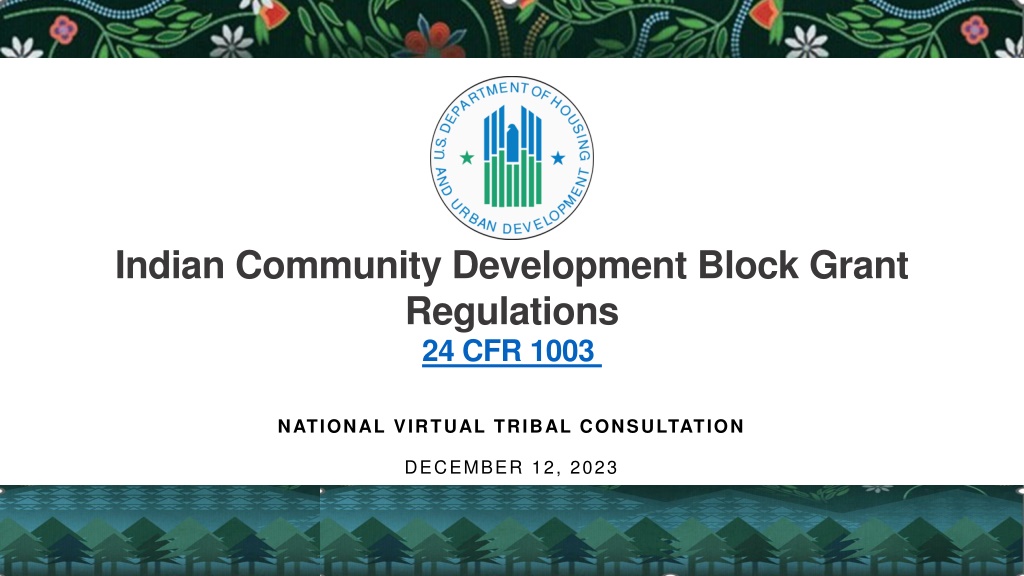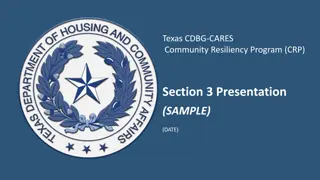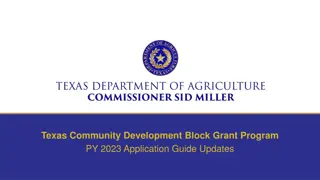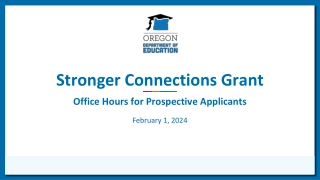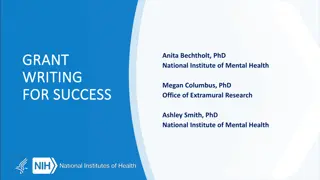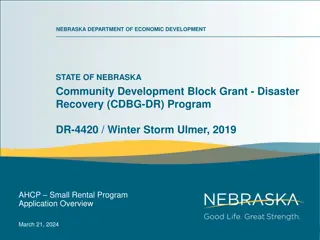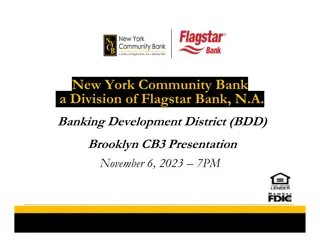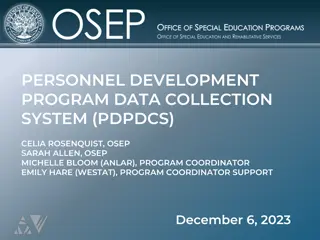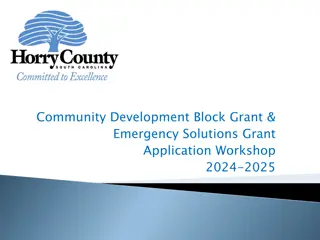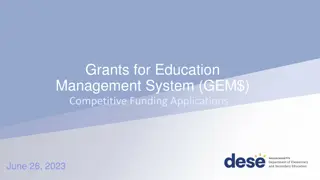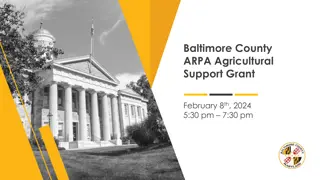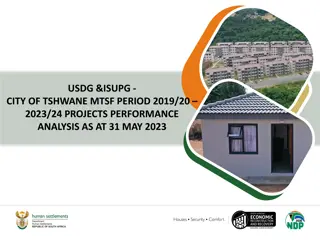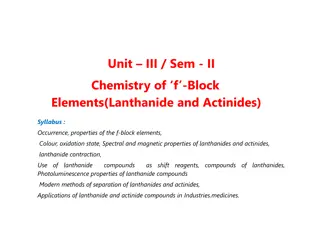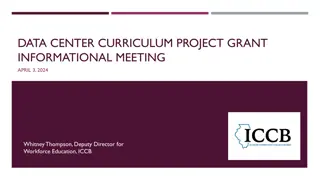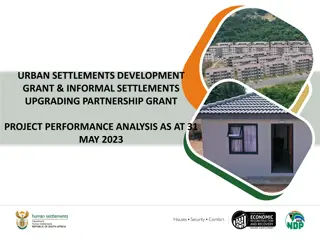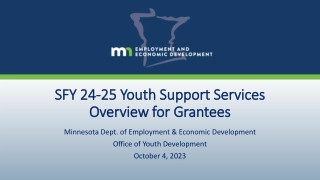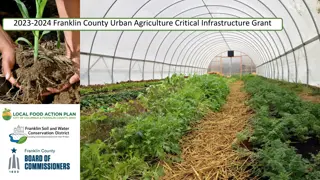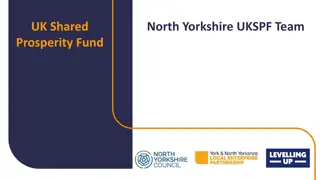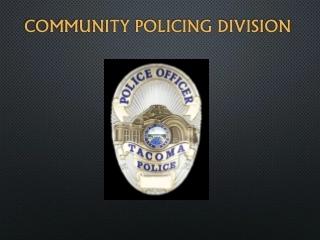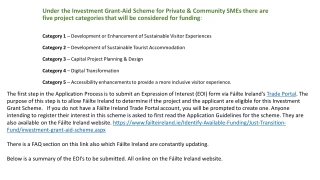Indian Community Development Block Grant Program Overview
The Indian Community Development Block Grant (ICDBG) Program provides funding to Tribal communities for housing, community development, and economic development for low- and moderate-income individuals. The program details funding availability for FY2022 and FY2023, project examples, and key personnel involved in managing the grants.
Download Presentation
Please find below an Image/Link to download the presentation.
The content on the website is provided AS IS for your information and personal use only. It may not be sold, licensed, or shared on other websites without obtaining consent from the author. Download presentation by click this link. If you encounter any issues during the download, it is possible that the publisher has removed the file from their server.
Presentation Transcript
Indian Community Development Block Grant Regulations 24 CFR 1003 NATIONAL VIRTUAL TRIBAL CONSULTATION DECEMBER 12, 2023
Agenda ICDBG Overview Current ICDBG regulations Consult on needed updates to the regulations Gather comments and feedback
Office of Native American Programs Jad Atallah, Director, Office of Performance and Planning Hilary Atkin, Director, Office of Grants Management Damon Adams, Grant Management Specialist
Overview The Indian Community Development Block Grant (ICDBG) Program provides funding to Tribal communities to develop housing, community development and support economic development for low- and moderate-income persons.
Overview FY2022 Funding Available $95,565,820 Awards Applications received: 143 Number of awards: 55 Announced date: May 22, 2023 Minimum Award Amount $500,000 Press Release Maximum Award Amount $5,000,000 Project Summaries
Overview FY2023 Applications received: 150 Anticipated number of awards: 80 Application due date: October 5, 2023 Anticipated awards: April 2024 Funding Available $75,000,000 Minimum Award Amount $500,000 Press Release Maximum Award Amount $5,000,000
Project Examples Rehabilitation New Housing Construction, Infrastructure Community Facilities Rehabilitate the plumbing and electrical systems for 20 homes and acquire 10 homeownership modular units for low- and-moderate income Tribal families. Provide infrastructure installation for 8-10 homes for low- and-moderate income Tribal families. Build an education center for low- and- moderate income Tribal members. Construct a multi-purpose Community Facility that will provide space for community support programs, youth programs, a Tribal library, and a computer center. Replace roofs on 196 low-rent, single- family and duplex units for low- and- moderate income Tribal families. Construct 3 housing units to increase access to affordable housing for low- and-moderate income Tribal families. Construct Tribal Community Elder Facility which includes residential units, community gathering areas, dining, office space, and storage space. The facility will exclusively benefit low- and- moderate income elders. Rehabilitate 27 homes to improve access to affordable housing for low- and-moderate income Tribal households. Constructing a 4,282 square foot Wellness Center to benefit low- and- moderate income Tribal members.
Overview Grant Types Single Purpose Grants Competitive grants awarded through NOFO *Apply through Grants.gov Imminent Threat Grants Noncompetitive grants awarded 1st come, 1st served no due date *Apply directly through the Area ONAP More Information: Imminent Threat grant guidance: ONAP Program Guidance 2018-04 ICDBG regulations: 24 CFR Part 1003
Overview Categories of Major Eligible Activities Housing Rehabilitation, land acquisition, and under limited circumstances, new housing construction. Community Facilities Infrastructure construction, e.g., roads, water and sewer facilities, and single or multipurpose community buildings. Economic Development Commercial, industrial, agricultural projects which may be recipient owned and operated or which may be owned and/or operated by a third party. *** Please note, a more detailed description along with exceptions may be found in 24 CFR 1003 Subpart C
Overview ICDBG Imminent Threat (IT) Grants Intended to alleviate or remove imminent threats towards health or safety. Conditioned upon that an emergency exists or would exist if the threat was not addressed. Must address threats that were not evident at the time of the ICDBG single-purpose funding cycle, or that require immediate action. MAXIMUM AWARD AMOUNT: $450,000 for disasters that are not Presidentially-declared $900,000 for Presidentially declared disasters, also referred to as Major Disaster Declarations by the Federal Emergency Management Agency (FEMA). ** We plan to update ICDBG-IT program guidance soon
Current ICDBG Regulations The current regulations promote community development with a focus on capital costs ( bricks and mortar ) and an emphasis on community facilities, infrastructure and economic development. The regulations outline the requirements we all know and love: Eligibility Imminent threat NOFO rating factors And more!
Consultation 24 CFR part 1003 has not been updated in two decades. ONAP seeks to follow HUD s Tribal Consultation Policy to seek feedback from tribal communities on ways to revise and improve the ICDBG regulations. HUD is interested in hearing about all topics but is particularly interested in the areas in the following slides.
Comments and Feedback Area ONAP allocation of ICDBG funds (24 CFR 1003.101) Comments regarding the distribution of funds to each region? $1,000,000 base amount for each AONAP Remaining amount (less IT set-aside) distributed as follows, based on ACS data: 40% allocated based upon each AONAP's share of the total eligible Indian population 40% allocated based upon each AONAP's share of the total extent of poverty among the eligible Indian population; and 20% of the funds allocated based upon each AONAP's share of the total extent of overcrowded housing among the eligible Indian population.
Comments and Feedback Should HUD expand or modify the activities that are currently eligible under the program? Program emphasizes hard costs such as construction (public facilities, infrastructure, housing) Not eligible: equipment, furnishings, operating & maintenance (statutory limitations) New housing construction is subject to specific threshold requirements and must be undertaken by a CBDO Housing rehabilitation is subject to specific threshold requirements (statements around rehab standards/policies and homeowner payments) * Please note, more detailed description of eligible & ineligible activities are located at 24 CFR 1003 Subpart C
Comments and Feedback Eligible Applicants: Tribal Organizations may apply on behalf of Indian tribes, but must provide a letter from BIA or IHS demonstrating eligibility under Title I of ISDEAA TDHEs sometimes have challenges with this
Comments and Feedback Should HUD align how it determines whether a household is low and moderate income with NAHASDA income criteria? ICDBG Criteria NAHASDA Criteria Low-income families are those whose income does not exceed 80% the median income for the area or the United States, whichever is greater. Low- and moderate-income beneficiaries are those whose incomes do not exceed 80% the median income for the area.
Comments and Feedback NOFO Rating Factors 1. Capacity 2. Need/Extent of the Problem 3. Soundness of Approach 4. Leveraging of Resources 5. Comprehensiveness and Coordination *Rating Factors included in the Notice of Funding Opportunity (24 CFR 103.303)
Comments and Feedback Imminent Threat Grants (24 CFR 1003 subpart E) In 2022, the Government Accountability Office issued a report on how agencies can address environmental threats for Alaska Native Villages. The requirements for the ICDBG IT program were cited as a barrier to addressing climate change with Federal funds. Would you have any concerns with changing the unique, unusual, nonrecurring requirements for IT projects? Should Tribes be required to certify that there are no other available Tribal resources before qualifying for an ICDBG IT grant?
Comments and Feedback Status and Evaluation Report (due within 45 days end of FFY) Progress. The progress made in completing approved activities should be described. This description should include a listing of work remaining together with a revised implementation schedule, if necessary. Expenditure of funds. A breakdown of funds spent on each major project activity or category should be provided. Program performance. Data on program outputs and outcomes, in a form prescribed by HUD. Grantee assessment. If the project has been completed, an evaluation of the effectiveness of the project in meeting the community development needs of the grantee should be provided. Minority Business Enterprise Reports Grantees shall submit to HUD, by October 10, a report on contract and subcontract activity during the fiscal year. Close Out *Reporting requirements (24 CFR 1003.506 Reports & 24 CFR 1003.508 Grant closeout procedures)
Comments and Feedback Please state your name, Tribe, and which area of the regulation you are responding to. Eligible and ineligible activities (24 CFR 1003 subpart C); Area ONAP allocations of ICDBG funds (24 CFR 1003.101); Compliance with the primary objective (24 CFR 1003.208); Rating factors included in the Notice of Funding Opportunity (24 CFR 1003.303); ICDBG Imminent Threat Grants (24 CFR 1003 subpart E); and Reporting requirements (24 CFR 1003.506).
Consultation Upcoming Sessions Continued consultations in ONAP Regions through spring 2024 Next Steps Publication of a draft proposed new rule in the Federal Register in 2024. Once published, DTL will be issued for another series of tribal consultations.
Thank You For Your Input! Please ensure interested members of your community are aware of the proposed updates to 24 CFR part 1003 and provide input on changes to the regulation. Submit comments to: Consultation@hud.gov
